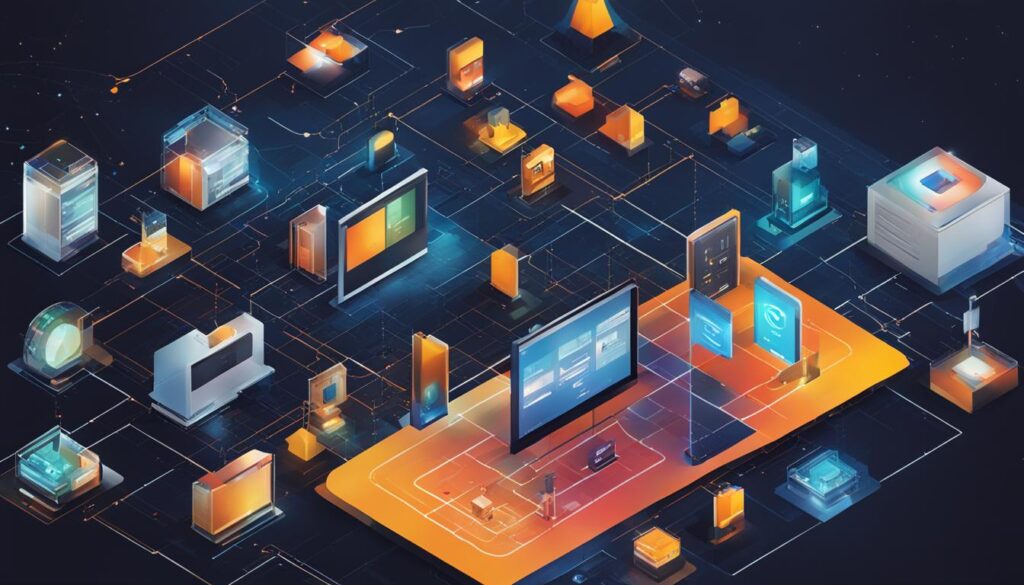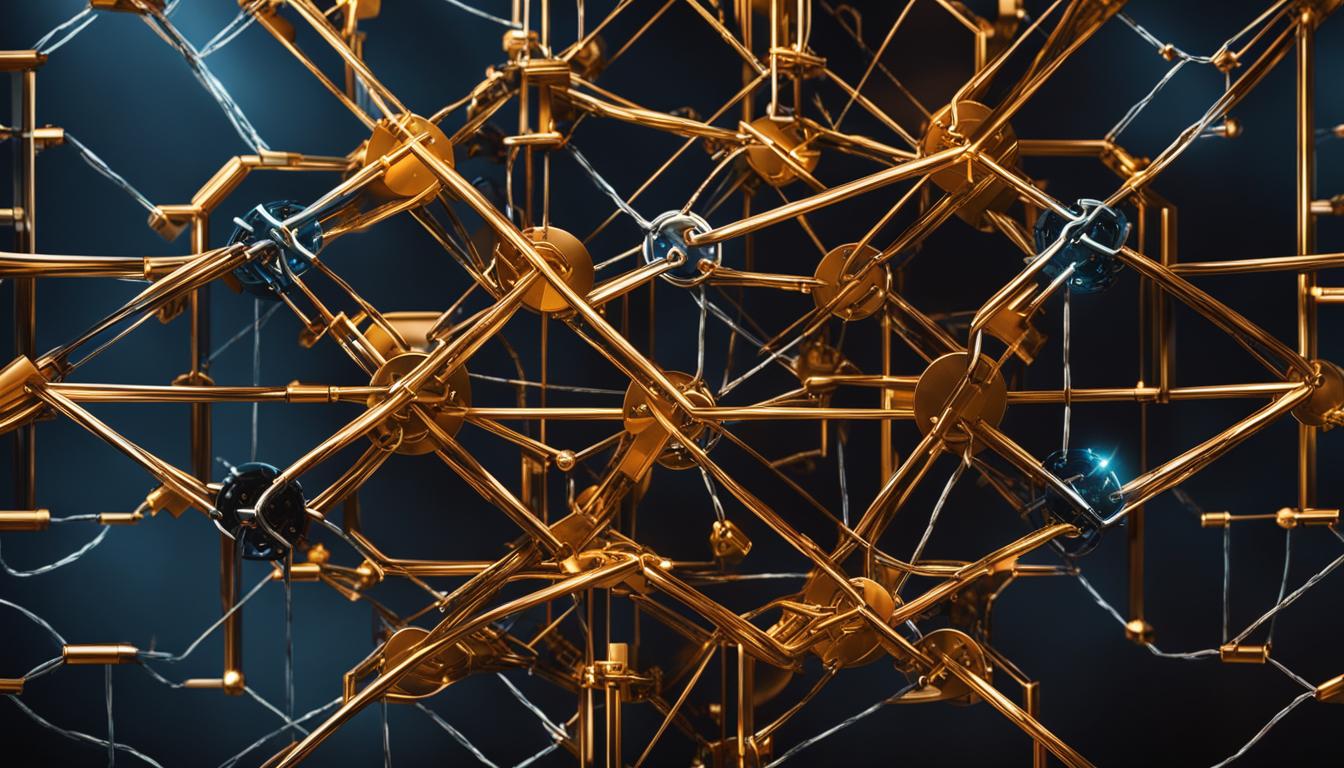The rise of the cloud has revolutionized the business realm, with AWS, Azure, and GCP being the major players in cloud computing. This article aims to provide insights into AWS IoT and Azure IoT, addressing the question of which platform truly stands out.
Key Takeaways:
- Comparing IoT Platforms: AWS IoT vs. Azure IoT
- AWS IoT offers over 200 tailored solutions, while Azure IoT excels in integration with Microsoft products.
- AWS IoT’s Management Console and exhaustive documentation enhance usability, while Azure IoT boasts a familiar Windows-inspired UI.
- AWS IoT provides reliable infrastructure and benchmark services, while Azure IoT shines in Windows-based applications.
- AWS IoT offers scalability through elasticity, while Azure IoT leverages Kubernetes Service and Azure Autoscaling.
- AWS IoT provides robust SDKs and AWS Direct Connect for integration, while Azure IoT offers native integration with Azure Logic Apps and Azure Integration Services.
- AWS IoT dominates the market share, but the ultimate choice between the platforms depends on specific enterprise needs and priorities.
Functionality Comparison
When comparing AWS IoT and Azure IoT in terms of functionality, it is important to consider the unique features and offerings of each platform. AWS IoT stands out with its extensive range of over 200 tailored solutions, catering to various industry needs. From specialized tools for IoT, database management, to even quantum computing, AWS provides a comprehensive suite of services for businesses of all sizes.
On the other hand, Azure IoT excels in its integration and harmonization with the broader Microsoft ecosystem. This makes it a preferred choice for businesses already heavily invested in Microsoft products and technologies. Azure IoT seamlessly integrates with tools like Azure Logic Apps and Azure Integration Services, enabling businesses to leverage the full potential of their existing Microsoft infrastructure.
Let’s dive deeper into the specific features offered by AWS IoT and Azure IoT in this functionality comparison:
Features
Below is a comparison table highlighting some key features of AWS IoT and Azure IoT:
| Features | AWS IoT | Azure IoT |
|---|---|---|
| Data Management | Amazon Kinesis, AWS IoT Analytics | Azure IoT Hub, Azure Time Series Insights |
| Device Management | AWS IoT Device Management, AWS Device Defender | Azure IoT Device Provisioning Service, Azure IoT Hub Device Management |
| Edge Computing | AWS IoT Greengrass | Azure IoT Edge |
| Integration | AWS Lambda, AWS Step Functions | Azure Functions, Azure Logic Apps |
As seen from the table, both AWS IoT and Azure IoT provide robust data and device management capabilities. AWS offers solutions like Amazon Kinesis and AWS IoT Analytics for efficient data management, while Azure provides Azure IoT Hub and Azure Time Series Insights for similar purposes.
When it comes to device management, AWS IoT offers AWS IoT Device Management and AWS Device Defender, while Azure IoT provides Azure IoT Hub Device Management and Azure IoT Device Provisioning Service.
Edge computing, which is crucial for processing data at the edge of the network, is addressed by AWS IoT Greengrass and Azure IoT Edge. Both platforms offer edge computing capabilities to cater to the unique needs of IoT deployments.
Overall, AWS IoT and Azure IoT have their own strengths and capabilities when it comes to functionality. The choice between the two platforms will depend on the specific requirements and preferences of each business.
Usability Comparison
When it comes to comparing the usability of AWS IoT and Azure IoT, both platforms offer their unique advantages. AWS’s Management Console is known for its detailed design and comprehensive documentation, providing users with a user-friendly interface to manage and monitor their IoT applications. Additionally, AWS has introduced the “Well-Architected Framework” to assist users in designing optimal and secure IoT systems.
On the other hand, Azure IoT boasts a familiarity factor with its Windows-inspired UI, making it a preferred choice for businesses already invested in the Microsoft ecosystem. The integration of Azure with developer-friendly tools like Visual Studio and GitHub further enhances its usability, allowing developers to seamlessly work within their preferred environments.
Table: Usability Comparison
| AWS IoT | Azure IoT | |
|---|---|---|
| User Interface | Detailed design and intuitive Management Console | Windows-inspired UI and integration with Visual Studio and GitHub |
| Documentation | Comprehensive documentation and “Well-Architected Framework” | N/A |
| Developer-Friendly Tools | N/A | Integration with Visual Studio and GitHub |
Both AWS IoT and Azure IoT strive to provide users with a seamless experience in managing their IoT deployments. While AWS focuses on detailed documentation and a well-designed console, Azure capitalizes on its integration with existing Microsoft tools and a familiar UI. Ultimately, the choice between the two platforms will depend on the specific needs and preferences of the businesses leveraging IoT capabilities.
AWS IoT vs. Azure IoT: A Performance Comparison
When it comes to performance, both AWS IoT and Azure IoT have their respective strengths and advantages. AWS is renowned for its robust infrastructure and benchmark services, delivering reliable and scalable solutions for businesses of all sizes. Azure, on the other hand, excels in Windows-based applications, leveraging its integration with Windows Server technology to provide seamless performance and compatibility.
For AWS IoT, key services like EC2 (Elastic Compute Cloud) and S3 (Simple Storage Service) play a crucial role in delivering exceptional performance. EC2 offers compute capabilities with Auto Scaling, allowing businesses to dynamically adjust resources based on demand. S3 provides scalable object storage, ensuring data availability and durability. These services, combined with AWS’s extensive global network of data centers, contribute to the platform’s outstanding performance in handling IoT workloads.
Azure IoT, with its deep integration into the broader Microsoft ecosystem, shines in delivering high-performance solutions for Windows-based applications. Leveraging Windows Server technology, Azure offers seamless compatibility and optimized performance for businesses already utilizing Microsoft products. This integration allows for efficient data processing, real-time analytics, and streamlined communication between IoT devices and the cloud. With Azure’s integration capabilities, businesses can leverage existing tools like Visual Studio and GitHub, making it a preferred choice for developers.
Scalability Comparison
Scalability is a crucial factor when considering an IoT platform, as businesses need to ensure that their solutions can handle increasing demand and accommodate future growth. Both AWS IoT and Azure IoT offer robust scalability features that enable organizations to scale their deployments efficiently.
Scalability in AWS IoT
AWS IoT provides companies with a range of scalability options. One of the key features is Auto Scaling, which allows businesses to automatically adjust the capacity of their resources based on predefined rules. This ensures that the system can handle spikes in traffic and scale down during periods of low demand, optimizing costs and performance.
Another essential scalability feature of AWS IoT is AWS Lambda. This serverless compute service allows developers to run their code in response to events, eliminating the need to provision and manage servers. With AWS Lambda, businesses can easily scale their IoT applications without worrying about infrastructure management.
Scalability in Azure IoT
Azure IoT offers its own set of scalability capabilities to meet the needs of businesses. One notable feature is the Azure Kubernetes Service (AKS), which enables the deployment, scaling, and management of containerized applications using Kubernetes. AKS ensures that applications can seamlessly scale up or down based on demand, providing flexibility and reliability.
Azure Autoscaling is another powerful tool that allows organizations to automatically adjust the number of IoT resources based on predefined rules. This ensures that businesses can efficiently handle varying workloads and deliver optimal performance to their users.
| AWS IoT Scalability | Azure IoT Scalability | |
|---|---|---|
| Key Feature | Auto Scaling | Azure Kubernetes Service (AKS) |
| Additional Feature | AWS Lambda | Azure Autoscaling |
As shown in the table, both AWS IoT and Azure IoT provide robust scalability capabilities. AWS IoT excels in its Auto Scaling feature and the serverless computing power of AWS Lambda. On the other hand, Azure IoT shines with its Azure Kubernetes Service (AKS) and Azure Autoscaling features.
When choosing between the two platforms, businesses should consider their specific scalability requirements and how well each platform aligns with their needs. It’s crucial to evaluate not only the scalability features but also the overall ecosystem and integration capabilities of AWS IoT and Azure IoT.
AWS IoT Integration Capabilities
AWS IoT offers robust integration capabilities that enable seamless connectivity and interoperability with various systems and applications. The platform provides extensive support for integration through a range of tools and services, making it a versatile choice for businesses looking to connect their IoT devices.
SDKs for Multiple Programming Languages
AWS IoT offers software development kits (SDKs) for popular programming languages such as Java, Python, C++, and JavaScript. These SDKs provide developers with the necessary tools and resources to build IoT applications and connect their devices to the AWS IoT platform. The SDKs simplify the integration process by providing pre-built libraries and APIs, reducing the development time and effort required.
AWS Direct Connect
AWS IoT also offers AWS Direct Connect, a dedicated network connection that provides a private and secure connection between an organization’s on-premises infrastructure and the AWS cloud. This service allows for faster data transfer, lower latency, and enhanced security, making it ideal for organizations that require direct and reliable connectivity to their IoT devices in the cloud.

Third-Party Integrations
AWS IoT supports integration with a wide range of third-party services and platforms, allowing businesses to leverage existing tools and systems. The platform offers seamless integration with popular services like Amazon S3 for data storage, AWS Lambda for serverless computing, and Amazon Kinesis for real-time data streaming and analytics. These integrations enable businesses to enhance the capabilities of their IoT applications and leverage additional services provided by AWS.
| Integration | Description |
|---|---|
| Amazon S3 | Securely store and retrieve data generated by IoT devices |
| AWS Lambda | Run code without provisioning or managing servers |
| Amazon Kinesis | Collect, process, and analyze real-time streaming data |
| Amazon DynamoDB | Store and retrieve any amount of data, at any time, from anywhere |
| Amazon Redshift | Analyze large datasets with a petabyte-scale data warehouse |
By leveraging these integration capabilities, businesses can enhance the functionality and scalability of their IoT applications, enabling them to derive valuable insights from their devices and drive business growth.
Azure IoT Integration Capabilities
Azure IoT offers a comprehensive suite of integration capabilities that enable businesses to seamlessly connect their IoT devices, applications, and systems. The platform provides a wide range of tools and services, making it a preferred choice for organizations looking to drive innovation and digital transformation through IoT.
Azure Logic Apps
Azure Logic Apps is a cloud-based service that provides a visual designer for building and orchestrating workflows. This powerful tool enables businesses to automate tasks, integrate systems, and streamline processes by connecting various applications and services. With Azure Logic Apps, businesses can easily integrate their IoT devices and applications with other systems, enabling seamless data flow and efficient communication.
Azure Integration Services
Azure Integration Services is a collection of cloud services that enable businesses to connect applications, data, and services across on-premises and cloud environments. The services include Azure Service Bus, Azure Event Grid, Azure API Management, and Azure Data Factory, among others. These services provide the necessary tools and infrastructure to build scalable and reliable integration solutions, ensuring efficient and secure communication between IoT devices and other systems.
Microsoft Power Platform
The Microsoft Power Platform, which includes Power Apps, Power Automate, and Power BI, offers a suite of low-code and no-code tools that empower businesses to create custom applications, automate workflows, and gain insights from their data. With Azure IoT integration capabilities, businesses can leverage the Power Platform to build intuitive and user-friendly applications that interact with IoT devices, enabling them to visualize and analyze data in real-time.
With these integration capabilities, Azure IoT empowers businesses to seamlessly connect their IoT devices with other systems and applications, enabling them to unlock the full potential of their IoT initiatives and drive digital transformation.
Conclusion
After a comprehensive comparison of AWS IoT and Azure IoT, it is clear that both platforms have their unique strengths and advantages. AWS IoT offers a wide range of tailored solutions and services, making it a market leader in terms of functionality and reliability. On the other hand, Azure IoT excels in its seamless integration with the broader Microsoft ecosystem, making it an attractive choice for businesses already invested in Microsoft products.
While AWS maintains a slight lead in market share, the ultimate selection between AWS IoT and Azure IoT depends on the specific needs and priorities of the enterprise. If comprehensive functionality and a proven track record are top priorities, AWS IoT is the way to go. However, for businesses seeking harmonious integration with existing Microsoft products and hybrid capabilities, Azure IoT presents a compelling option.
It’s important to note that GCP, with its competitive pricing and data analytics prowess, also deserves consideration for businesses looking for an alternative. Ultimately, the decision should be based on a careful evaluation of the unique requirements of each enterprise, ensuring that the chosen platform aligns with long-term goals and objectives.
FAQ
What are the main differences between AWS IoT and Azure IoT?
AWS IoT offers over 200 tailored solutions, specialized tools for IoT, database management, and quantum computing. Azure IoT excels in its harmonization with the broader Microsoft ecosystem, making it a preferred choice for businesses invested in Microsoft products.
Which platform has a more user-friendly interface?
AWS IoT has a detailed design and exhaustive documentation in its Management Console. Azure IoT boasts a familiarity factor with its Windows-inspired UI and integration with developer-friendly tools like Visual Studio and GitHub.
What are the key performance aspects of AWS IoT, Azure IoT, and GCP?
AWS IoT is known for its reliable infrastructure and benchmark services like EC2 for compute capabilities and S3 for storage. Azure IoT performs well in Windows-based applications due to its integration with Windows Server tech. GCP capitalizes on Google’s global infrastructure for fast and reliable services, especially in data analytics.
How do AWS IoT, Azure IoT, and GCP handle scalability?
AWS IoT offers services like EC2 for elasticity and Auto Scaling, as well as AWS Lambda for evolving demands. Azure IoT’s scalability is exemplified by its Kubernetes Service (AKS) and Azure Autoscaling. GCP’s App Engine adjusts VM instances as traffic dictates, allowing businesses to focus on code.
What integration capabilities do AWS IoT and Azure IoT offer?
AWS IoT offers robust SDKs for various programming languages and AWS Direct Connect for dedicated connections. Azure IoT excels in native integrations with tools like Azure Logic Apps and Azure Integration Services. GCP ensures broad compatibility, especially for Linux-centric tasks, with its hybrid cloud solution Anthos.
 Skip to main content
Skip to main content


